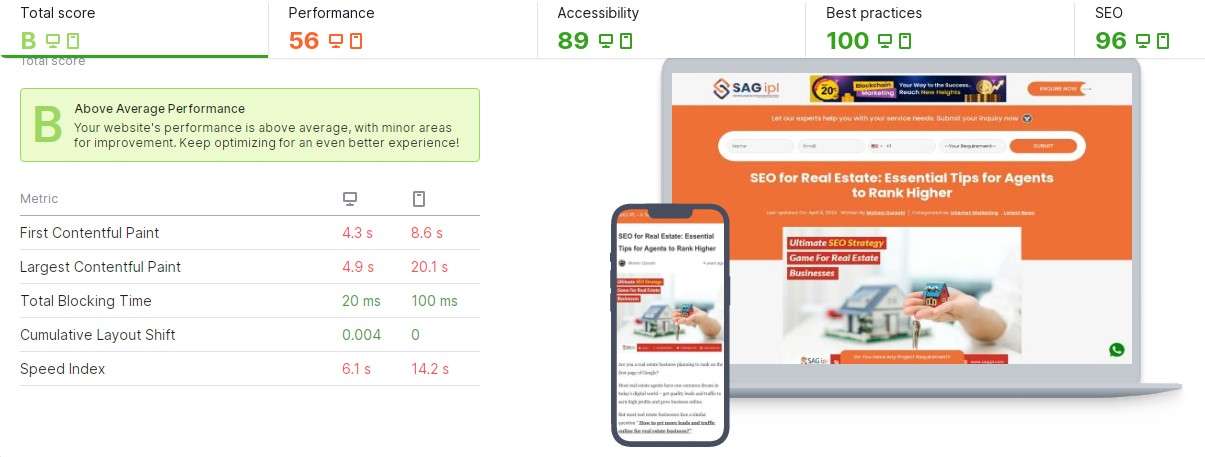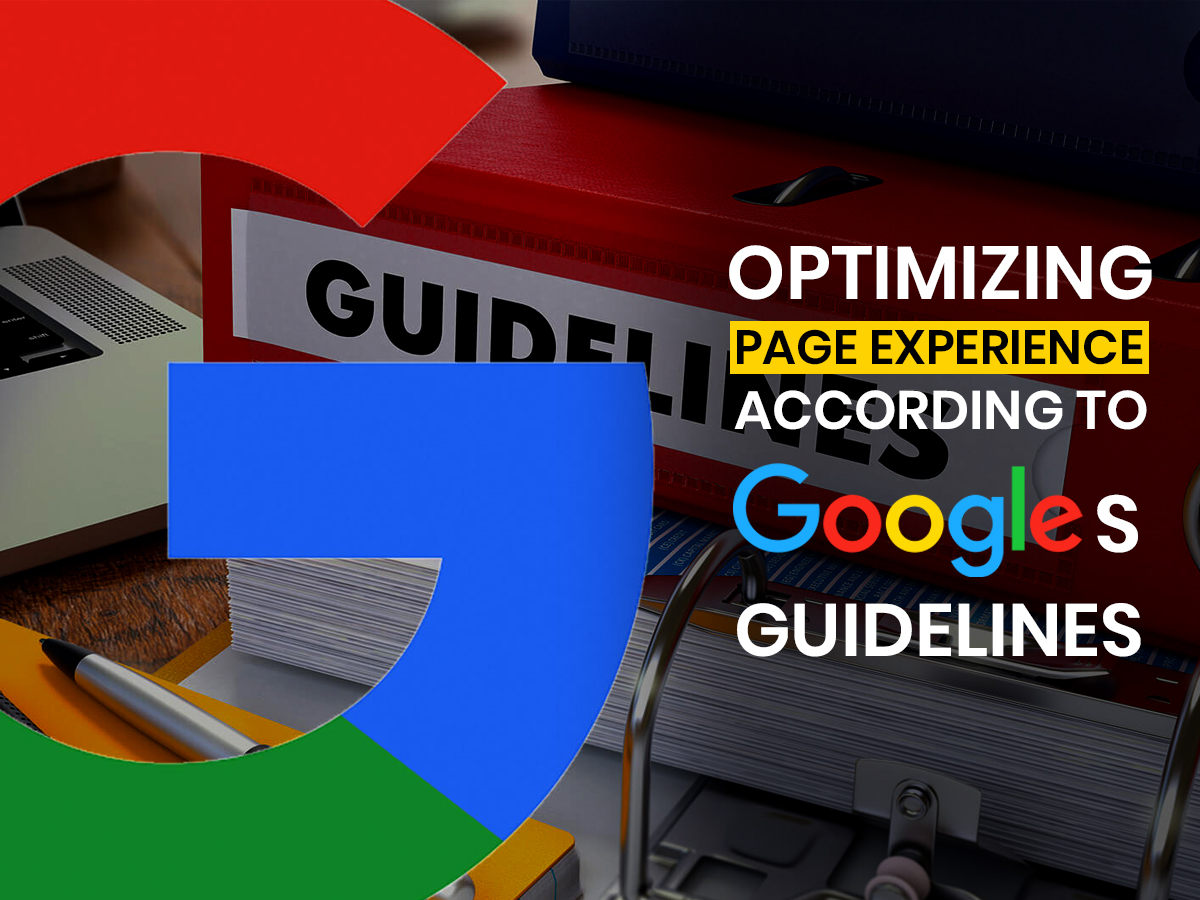Many factors contribute to the user experience of a web page. Page Speed is one of the most important. Web pages with a high loading speed are known to attract and retain more users. Looking for more such interesting site speed statistics? Then, you’re at the right place.
Site speed or page speed is a crucial search engine optimization (SEO) factor and an integral part of the On-page SEO. It involves optimizing the speed of a web page to reduce load time to attract and retain more visitors to the site, contributing to a better user experience.
Google ranks pages with great user experience higher in search results. Improving your page speed can help enhance user experience and boost your organic search rankings.
Want to Boost Your Loading Time? Fill out this form!
What is Page Speed and Why is it Important for SEO?
Page Speed refers to the speed of a web page, i.e. how fast a page loads or how much time it takes to load (page load time). Pages with optimized speed load fast. The higher the page speed, the better the user experience.

Page speed optimization involves identifying and improving technical errors on a web page, such as canonical errors, JavaScript, etc. to increase the speed and reduce the loading time of a page.
Why is page speed important for SEO and ranking?
Users like websites that load fast. This ensures that they can quickly find what they’re looking for on a web page without wasting a lot of time waiting for the page to load. So, higher page speed translates to improved user experience. Most users leave a web page if it takes more than a few seconds to load. This increases the bounce rate, which is bad for your search rankings.
Google treats user experience as an important factor when determining the search rankings of a web page. If many visitors leave your site because the pages take too much time to load, it results in poor user experience, which might affect your search rankings.
All in all, you need to optimize your page speed if you want to improve your site’s user experience and rank higher in organic search results.
As a part of our commitment to helping businesses succeed online, we’re today sharing some fascinating page speed statistics and figures to help our readers understand the importance of page speeds for the success of digital marketing or SEO campaigns.
Site Speed Statistics & Facts for 2024
If you’re wondering whether page speed still matters in 2024, please read these latest site speed statistics and facts to understand the importance of page speed optimization.
1. According to research, more than 40% of visitors leave a website if it takes over two to three seconds to load.
2. Around 39% of visitors are found to lose interest in a website if images take time to load.
3. More than 70% of users report that they have come across a slow-loading website on mobile.
4. E-commerce sites with loading times under 1 second have 3x higher conversion rates.
5. Over 80% of online shoppers accept that slow page speeds affect their purchasing decisions.
6. Slower page speed leads to an increased bounce rate, which is the percentage of visitors leaving a website after browsing only one page.
7. On average, pages with a 3-second load time have a 32% higher bounce rate than pages with a 1-second load time.
8. According to a Tooltester report, the average desktop website load time was 2.5 seconds in 2023.
9. At the same time, the average mobile website load time was over 8 seconds, meaning an average mobile site or page took more than 8 seconds to load.
10. Web pages and sites ranking on the first page of Google have an average page speed of 1.65 seconds.
11. According to experts, the ideal page load time is 2 to 3 seconds. Beyond this, your website starts losing visitors as the bounce rate increases.
12. The number of users leaving your site unchecked depends on wait times for page load. For websites loading under 1 second, 7% is the average user loss. It increases to over 28% for pages with a load time of 5 seconds or more.
13. The average website page speed, according to Pingdom, is 3.21 seconds.
14. Every 1 in 4 visitors leave a website if the loading time is more than 4 seconds.
15. According to a study, only 34% of websites are optimized for page load speed/time.
16. 83% of online consumers expect websites to load under three seconds.
17. Every 1-second delay in page load time decreases user experience by 16% and reduces conversion rate by around 4.4 percent.
18. Conversion rate is directly proportional to page speed. Improving your page loading speed by only 1 second can boost your site’s conversion rate by up to 100%.
19. 46% of users don’t revisit websites or pages where they previously had poor experience due to slow loading times.
20. The average page load time of B2B sites is under 5 seconds. B2B sites with a page speed of 1 second have around 3 times higher conversion rate than an average site.
21. Over 70% of online users say they’d revisit a website with good page speed.
22. Around 64% of online shoppers leave a slow e-commerce website for a fast-loading site.
23. Time to First Byte (TTFB) is the time it takes for a web browser or mobile device to receive the first response from the server when trying to open a website.
24. Many top-ranking sites on Google have page load times of less than 0.5 seconds.
25. 86% of B2B website pages load in 5 seconds or less, according to a study by Portent.
26. The average bounce rate is 9% for a web page that loads within 2 seconds.
27. Optimizing Web Vitals (Google-recommended web page quality signals) improved a page’s loading performance by around 31%.
28. Average mobile page load speeds are considerably worse compared to desktop.
29. Web pages on mobile load around 70% slower than pages on desktops.
30. 50% of online users say they’d prefer websites without animation and videos if it results in faster load times.
31. On average, financial websites and pages take around 5.1 seconds to load.
32. Facebook’s prefetching content algorithm is known to improve a website’s load time on mobile by as much as 25% by offering prefetched content.
33. 53% of mobile users say they leave a page if it takes more than three seconds to load.
34. According to a study, the average time it takes for a web page to fully load on a desktop is 10.3 seconds. For mobile, the average time to fully load a website page is 27 seconds.
35. A major tech giant reportedly increased its website traffic by 9% by improving its page load speed by only 0.4 seconds.
36. Websites experience an improvement of almost 2 seconds in their page load time after changing their website platform/server provider, from worst to best.
37. 44% of online shoppers share reviews or talk with other people about their experience with websites.
38. On average, healthcare websites take around 5.6 seconds to load.
39. Industry-wise, technology and travel websites have the highest average loading times of 6.8 seconds and 6.7 seconds respectively.
40. Web pages on mobile take approximately 70% longer to load than on desktop.
41. According to BBC, 10 percent of its website users leave for every second delay in page load speed.
42. The top 20 websites in the United States have an average page speed of just 1.08 seconds.
43. The average page load time is higher for e-commerce websites than for other websites.
44. According to a study, 14% of online shoppers on mobile expect pages to load instantly.
45. 64% of mobile phone users expect pages to not take more than four seconds to load.
46. According to a study of US consumers, 74% of users say they would abandon mobile sites if they don’t load in less than five seconds.
47. According to a study of multiple top websites, Godaddy exhibited the highest average page load speed on mobile, which is 6.40 seconds.
48. Page Speed is one of the top 20 Google Ranking Factors, which indicates its importance for a website’s success.
49. Around 80% of consumers who had a bad experience with a website say they won’t visit or buy from it again.
50. A website with a page load time of 5 seconds is likely to experience 90% higher bounce than a website with 1 second load time.
51. 45.4% of online consumers are less likely to complete their purchases on slow websites.
52. 11.9% of online shoppers who had a bad experience due to a slow website are likely to tell a friend about it.
53. Websites with a page load time of 10 seconds or higher experience a 123% higher bounce than websites with a 1-second load time.
We learn from the above site speed statistics that page speed is extremely important for the success of a website. Now, let’s talk about some of the best ways to improve a website’s page speed.
Tips to Make Your Site Load Faster
Before discussing ways to improve page speed or reduce load time, it’s crucial to understand the common reasons for poor page speed.
The top reasons for slow load time include:
- Poor quality server or bad network performance
- Distant server location
- A lot of Flash content or heavy graphics
- Website receiving more traffic than the server can take
- Excessive use of JavaScript and CSS on the page
- Use of dense or complex web elements, including heavy code, on the page
- Inefficient caching techniques
- Displaying too many, graphic-rich ads on the page
- Not updating the CMS frequently
How to check your site or page’s load time?
The best way to analyze your website for page loading speeding is to use the Google PageSpeed Insights tool https://pagespeed.web.dev/

Just enter your page URL to get crucial insights related to your site/page’s speed, including suggestions to reduce load time and improve page quality.
How to Improve Website Loading Speed
Here are some proven ways to enhance your website’s page speed organically:
Enable text compression
Use tools such as GZIP, Deflate or Brotli to compress and optimize text-based resources on your website to minimize total network bytes. The tool can help reduce the size of large files and data on your website to improve the page loading speed.
Reduce unused CSS
Reduce unused CSS files and edit CSS to remove rules that are not needed. By removing or postponing secondary CSS, one can decrease the total network bytes. Additionally, reducing CSS files can help optimize network payload or data sizes.
Reduce unused JavaScript
JavaScript can seriously affect the performance of your site by increasing page load time. Reduce unused JavaScript from your website code and remove loading scripts, unless absolutely needed, to reduce network bytes.
Eliminate render-blocking resources
Render-blocking resources are elements on a page that prevent or delay the rendering of the page content by the browser or prevent the browser from reading page content. These elements increase the First Paint, i.e. the time it takes for the browser to render a page. Examples of render-blocking resources include JavaScript, CSS, and HTML imports.
Optimize Images
The loading speed of a page also depends on the quality and size of images on the page. To improve this, always set a width and height for every image on your page to reduce layout shifts and improve CLS (Cumulative Layout Shift).
To improve page speed, consider resizing and compressing images and graphical elements on your page without compromising quality.
Convert and use images in next-gen formats, such as WebP and AVIF, which may provide better compression and quality than older formats like PNG or JPEG, resulting in faster page loading. Use appropriately sized and compressed images to improve load time.
Enable Caching
Caching refers to the practice of storing certain web elements locally on the client side (browser) to reduce fetch time and improve user experience when visiting a site. Increasing the cache lifetime on your page can attract more repeat visitors.
Avoid enormous network payloads
Try to reduce network payloads, i.e. the amount of data transfer between the server and the client to reduce expenses and page load times.
Use a Content Delivery Network (CDN)
Rather than using a single server, consider using a Content Delivery Network (CDN) or a network of servers that can deliver fast web content based on the location of a user, reducing the server response time.
Switch to a High-performance Server
Of course, you can always switch to a better server if the main cause of your slow-loading website is your poor or inadequate server. As your website grows and you start receiving more visitors, it becomes important to upgrade your server capabilities to handle the increasing load.
Reduce and Optimize Redirects
Another good way to reduce page load time is to optimize your redirects. If you’re using canonical or 301 redirects on your website, make sure that there are no errors and that pages load properly. Remove unnecessary redirects to increase page load speed.
If you need professional help in optimizing your website to boost page speed and reduce loading times, contact SAG IPL for cost-effective SEO website optimization services.


![How to Increase Mobile Page Speed [10 Ways to Improve Score] How to Increase Mobile Page Speed](https://blog.sagipl.com/wp-content/uploads/2023/04/How-to-Increase-Mobile-Page-Speed-250x150.jpg)

![Mobile SEO Vs Desktop SEO: Why Mobile SEO is Crucial [2024] Mobile SEO Vs Desktop SEO](https://blog.sagipl.com/wp-content/uploads/2023/06/Mobile-SEO-Vs-Desktop-SEO-250x150.jpg)
![Mobile-Friendly Website to Increase Business Leads [2024] Mobile-Friendly Website](https://blog.sagipl.com/wp-content/uploads/2023/07/Mobile-Friendly-Website-250x150.jpg)





